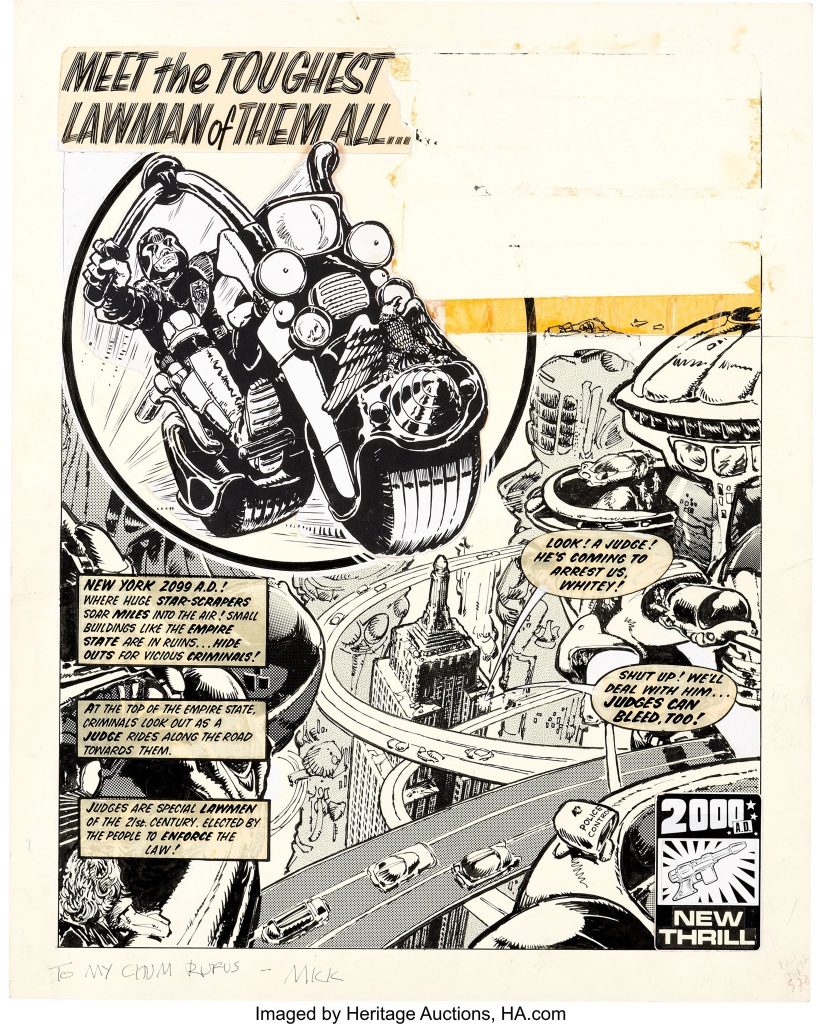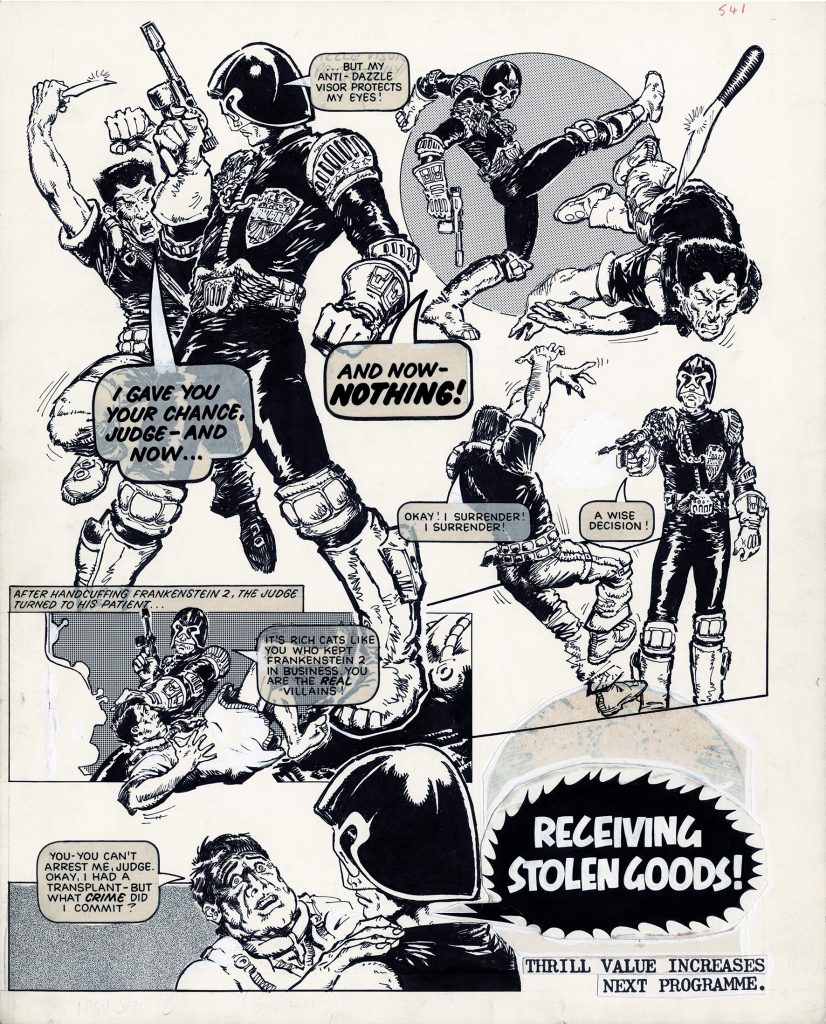
Mike McMahon’s first published “Judge Dredd” strip for 2000 AD, published in Prog 2 in 1977. The first panel is a stat of art by Carlos Ezquerra, who designed the character, co-created with John Wagner
The complete art for the first printed “Judge Dredd” strip from 2000 AD Prog 2, largely drawn by Mick McMahon – five pages in total – is one of the lots in the upcoming Heritage Auctions Comics, Comic Art and Animation Art auction in Dallas in November.
Arriving in 2000 AD Prog 2 1977, Judge Dredd, the toughest Lawman in Mega City One, was created by writer John Wagner and artist Carlos Ezquerra, but it was Mick McMahon’s take on the character that first stunned 2000AD readers. (Ezquerra’s first published Judge Dredd story, “Krong”, appeared in 2000 AD Prog 5, published in March 1977).
The five-page story, which Heritage Auctions describes as “easily the most important piece of UK comic book art we have ever offered”, was written by Peter Harris, extensively re-written Pat Mills who added a new ending suggested by Kelvin Gosnell, and introduces the Judges, future lawmen empowered to be Judge, Jury, and Executioner if need be, who rode the streets of the City on huge Lawbringer motorcycles, armed with their Lawgiver pistols.

Judge Dredd makes his first appearance in 2000Ad. Art by Mick McMahon
This opening story set all of that up, the Dredd figure inset image on Page One a stat paste-up of an image of Dredd by the late Carlos Ezquerra used in a promotional advertisement weeks in advance of publication, and published in the first Judge Dredd annual.
In 2001, Ezquerra recalled the initial brief for Dredd’s design went something like: “a menacing policeman dress in black and driving a motorbike”. Ezquerra was given an advertisement for the film Death Race 2000, showing the character Frankenstein (played by David Carradine) clad in black leather on a motorbike, as a suggestion of Dredd’s appearance.
“When I create a character, I’ll do it fairly quickly,” he noted, recalling the work took perhaps a couple of days. “The longer you stay working on an idea the more chances you have to spoil it and Dredd was not an exception. I drew the essentials: the grim face, black suit, menacing helmet (based on the Greeks), armour, and gun readily available when sitting on the bike. After that, I started to embellish the armour and bike with symbols”.
Carlos added that he wasn’t disappointed when McMahon’s version of Dredd was published ahead of his own after co-creating the character, although it did prompt him to return to Battle, creating gun-for-hire “El Mestizo” with Alan Hebden.
“I always think if somebody copies you, it is a form of flattery,” he said. “I was angry with the 2000 AD staff, because after creating Dredd and Mega-City, the first story published was not mine. So I left to go back to Battle, until Starlord was launched.”
“Dredd’s breast chain and badge actual predated punk fashion,” noted Steve MacManus in “The Judge Dredd Story”, published in 1994, “and with the black clad uniform, screened by a black helmet and his knee-length boots, he was the most exciting British comic book character that radiated menace.”
Ironically, Carlos Ezquerra was also to suffer problems with his designs for his take on the Judge Dredd movie version of character played by Sylvester Stallone. Collector Julius Howe has featured the designs on Comic Art Fans, noting Dredd’s likeness was originally intended to resemble the actor Sylvester Stallone, but Ezquerra said the sketches were rejected by Stallone’s agent because “he wasn’t handsome enough”.
John Wagner – who wasn’t keen on Ezquerra’s take on the character and whose first “Judge Dredd” story was rejected by IPC’s directors as “too violent” – also walked away from the title at the time, after a proposed buy-out of 2000 AD that would have improved creators’ terms and conditions fell through, noted in Thrill Powered Overload).
Although Carlos designed Judge Dredd, it was Mick McMahon who was to prove hugely influential in hammering out the look and feel of the character, although it’s Slaine who, he says, was his favourite 2000 AD character. He drew many of the “Judge Dredd” stories published between Prog 2 and Prog 196, his take on the character and the wild, crazy villains of the strip very much his own.
“As well as moulding Dredd’s helmet as if it was made of clay, McMahon treated readers to increasingly gigantic boots, and an array of sneering, snarling, and gleefully unkempt bad guys,” the Heroes of 2000AD blog notes. “Especially impressive was Rico Dredd, a man with so much invasive medical chicanery on his face, all other artists since have chosen to dial it back”.
Initially mimicking Ezquerra’s style at editor Pat Mills request, McMahon soon putting his own stamp on the character. I was tempted to use the word “refined”, but it’s not a good choice. McMahon’s early work on Dredd was anything but refined, coming at you with a raw, slap-in-the-face immediacy.
Heritage Auctions notes McMahon’s art – previously owned by artist Rufus Dayglo and, more recently, 2000 AD fan John Bamber – was created in ink and Zipatone on Bristol board with an image area of 13.5″ x 17.25″. All text is paste-up. Page One has a slit just below where the missing paste-up log would be, and a rip in each side margin. Page One is in Good condition, the others are in Very Good condition.
How much these pages will sell for is anyone’s guess…
True to the intense of amount of editorial work put into getting 2000 AD right from the get go, the story that appeared in Prog 2, known as “Judge Whitey”, was not the first Dredd strip drawn by McMahon. That was actually “Frankenstein II”, which ran in Prog 6, written by Malcolm Shaw, a creator who died young, better known for his work on girls comics, on stories such as “The Human Zoo” for Jinty.

The first “Judge Dredd” strip that Mick was commissioned to draw in 1976 – “Body Snatchers / Frankenstein2” eventually scheduled to be published in Prog 6, cover dated 2nd April 1977. Via Art Droids
The strip – commissioned at the same time as things went wrong for Action – had to be edited for excessive violence, which you can see on this original art offered for sale on ArtDroids, and 2000 AD‘s editorial staff were forced to rein in violent content by IPC Publishers
• View the “Judge Dredd” art published in 2000AD Prog 2 by Carlos Ezquerra here on Heritage Auctions
• Heritage Auctions – 2019 November 21 – 23 Comics – Dallas #7212 – Full Catalogue
WEB LINKS
• Heroes of 2000AD: Carlos Ezquerra
• A 2001 interview with Carlos Ezquerra, first published on Subhuman.net
• Judge Dredd The Movie – Character Design Sketches by Carlos Ezquerra 2000AD
• Heroes of 2000AD; Mick McMahon
Judge Dredd and 2000 AD © Rebellion Publishing Ltd
With thanks to David Roach for highlighting this auction item
• Books featuring the work of Mick McMahon on AmazonUK (Affiliate Link – help support downthetubes, thank you)
The founder of downthetubes, which he established in 1998. John works as a comics and magazine editor, writer, and on promotional work for the Lakes International Comic Art Festival. He is currently editor of Star Trek Explorer, published by Titan – his third tour of duty on the title originally titled Star Trek Magazine.
Working in British comics publishing since the 1980s, his credits include editor of titles such as Doctor Who Magazine, Babylon 5 Magazine, and more. He also edited the comics anthology STRIP Magazine and edited several audio comics for ROK Comics. He has also edited several comic collections, including volumes of “Charley’s War” and “Dan Dare”.
He’s the writer of “Pilgrim: Secrets and Lies” for B7 Comics; “Crucible”, a creator-owned project with 2000AD artist Smuzz; and “Death Duty” and “Skow Dogs” with Dave Hailwood.
Categories: 2000AD, Art and Illustration, Auctions, British Comics, Comic Art, downthetubes Comics News, downthetubes News, Other Worlds
 2000AD and Valiant art features in massive Heritage Auctions International Comic Art event
2000AD and Valiant art features in massive Heritage Auctions International Comic Art event  “Banned” Bolland Judge Dredd art up for sale
“Banned” Bolland Judge Dredd art up for sale  Samaritans founder Chad Varah’s Eagle and Girl comic rarities included in latest Phil-Comics auction
Samaritans founder Chad Varah’s Eagle and Girl comic rarities included in latest Phil-Comics auction  John M. Burns art heading to auction in aid of charity, SENSE
John M. Burns art heading to auction in aid of charity, SENSE